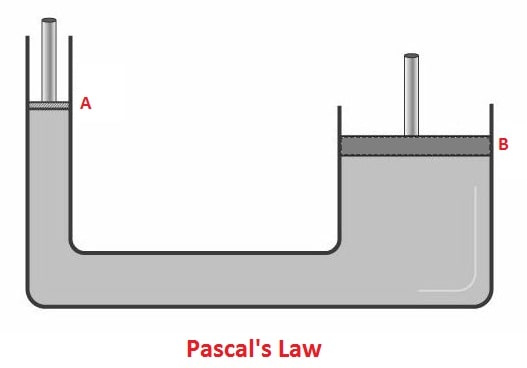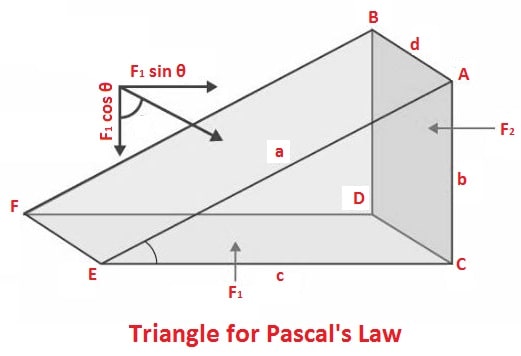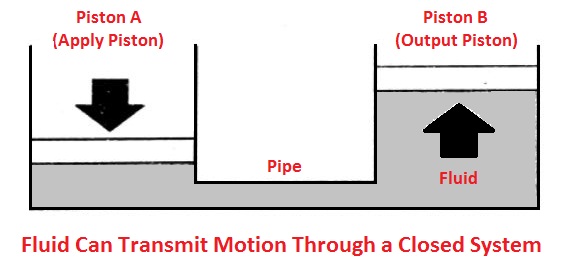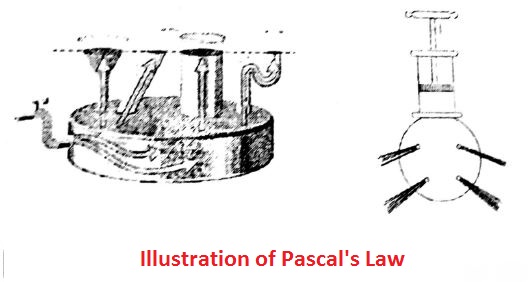In this post, you’ll learn what is Pascal’s law? and Explanation, Formula, Derivation, and the Applications of Pascal’s Law.
Definition of Pascal’s Law
Pascal’s law states that “the pressure or intensity of pressure at a point in a static fluid is equal in all directions”. It states that if pressure is applied to a non-flowing fluid in a container, then that pressure is transmitted equally in all directions within the container.
Pascal’s law states that when pressure is applied to fluids that are confined (or can’t) flow to anywhere), the fluids will then transmit (or send out) that same pressure in all direction at the same rate.
Read also: Fluid: Properties of Fluids [Briefly Explained]
Explanation of Pascal’s Law
It describes the effect of applying pressure on a fluid in a closed container. It states that pressure applied to an enclosed fluid is transmitted with equal force throughout the container.
If a liquid is confined and a force is applied, the pressure is produced. If the pressure on the fluid is employed to a movable output piston, it produces output force. Pascal manufactured the first known hydraulic equipment, which consisted of two sealed containers attached to a tube.

The pistons inside the cylinders seal against the walls of each cylinder and prevent the liquid from seeping out of the cylinder and restrict the air from entering the cylinder. When the piston in the first cylinder exerts a force, the pressure increases everywhere in the system. The force is carried through the connecting tube to the second cylinder.
The pressurized fluid in the second cylinder exerts a force on the bottom of the second piston, moves it upward, and carries a load over it. By using this tool, Pascal found that he could increase the force available to work, just as could be done with a lever or gear.
Pascal determined that the force applied to the liquid forms pressure or the transmission of force through the liquid. These experiments exposed two significant aspects of a liquid when it is defined and put under pressure. The pressure applied to it is transmitted equally in all directions, and this pressure acts with equal force at every in the container.
Read Also: Types of Flow Control Valves & Their Uses
Formula for Pascal’s Law
The following is the formula for Pascal’s law:
F = PA
Where,
- F be the force applied
- P be the pressure transmitted
- A be the cross-sectional area
Derivation of Pascal’s Law
Consider an arbitrary right-angled triangle in a liquid of density rho (ρ). Since the element is very small, each point is assumed to be at the same depth from the liquid surface. The effect of gravity is the same at all these points.

Let ab, bd, and cd be the cross-sectional area of the faces ABFE, ABDC, and CDFE, respectively.
Let P1, P2, and P3 be the pressure transmitted on the faces ABFE, ABDC, and CDFE.
The pressure exerts a force that is normal to the surface. Let P1 exert force F1 on the surface ABFE, P2 exert force F2 on the surface ABDC, and P3 exert force F3 on the surface CDFE, respectively.
Therefore,
F1 = P1 × area of ABFE = P1 ad
F2 = P2 × area of ABDC = P2 bd
And, F3 = P3 × area of CDFE = P3 cd
Also,

The prism’s net force will be zero because the prism is in equilibrium.
F1 sin θ = F2
F1 cos θ = F3
pressure,
P1 ad ba = P2 bd (equation-i)
P1 ad ca = P3 cd (equation-ii)
From (i) and (ii),
P1 = P2 and P1 = P3
∴ P1 = P2 = P3
Read Also:
Applications of Pascal’s Law
Following are the applications of Pascal’s law:
Pascal’s law applies to manufacturing equipment used in daily life, such as hydraulic jacks and hydraulic press. It is used in hydraulic brakes to increase resistive force in vehicle braking systems, water towers, and dams.
In addition, it is also helpful in hydraulic power systems in aircraft to slow down aircraft on the runway. Pascal’s law is also used to manufacture hydraulic pumps used in the automobile industry.
In addition, it is used in hydraulic testing of pressurized tanks, calibration of pressure gauges, pressing oils such as olive, hazelnut, and sunflower oils, etc. Tools like dentist’s drills, jackhammers, paint sprayers, and truck air brakes all work on the principle of Pascal’s law.
Some other applications of pascal’s law are described below.
Illustration 1
The liquid flows into the large container at the bottom. The pressure pushes the liquid equally up into the tubes above the container. The liquid increases to the same level in all tubes, although of the shape or angle of the tube.

Example: Hydraulic Jack
Read also: Difference Between Hydraulic and Pneumatic
Illustration 2
Consider a hollow sphere with a piston inside with a small hole at its edges. The sphere is loaded with water. As the piston moves, the water comes out of all holes.
The piston exerts equal pressure on the water surface. As a result, part of the water is squeezed out of the sphere in the form of jets flowing out of all the holes simultaneously, illustrating the pressure transmitted is the same in all directions.
Example: Raising of liquid in the surge tank.

Illustration 3
The mode of transmission of force in a solid and a liquid is as shown in the figure.

Examples: Pressure, Injection molding machine.
Closing It Up
That’s it, thanks for reading. If you have questions about “Applications of Pascal’s Law,” ask in the comments below. If you like this article, please share it with your friends.
Want Free PDFs direct to your inbox? Then Subscribe to our newsletter.
Download PDF of this article:
Read Next:
Dera sir, i am so happy to announce that your note become famous in our college and work plece. Thank you for your knowledge.
One request to you sir ….. can you please make a lesson on hydraulic symbol and it’s used.
Please sir my humble request to you and your team
Regard
Kuntal
West Bengal (India)
Thank you for your kind words! I’m thrilled to hear that the note is making an impact. I appreciate your request for a lesson on hydraulic symbols, and I’ll certainly consider it for future content.
This is a great article on the applications of Pascal’s Law. I learned a lot from it.
Thanks! Glad you found it helpful.
Thanks for this post
You’re welcome.
Excellent.
Thanks.